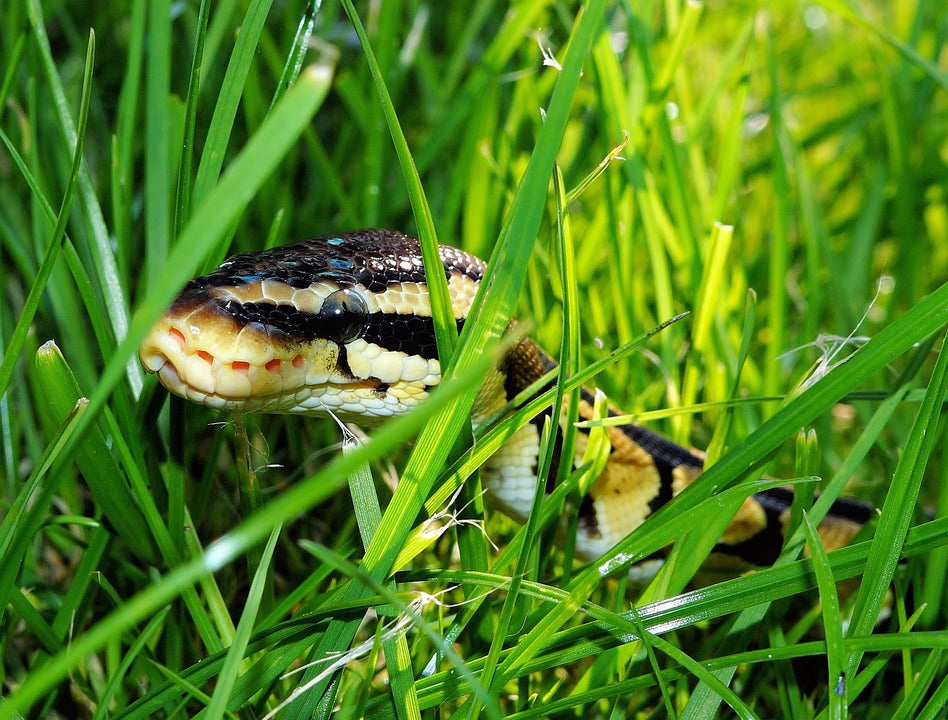Answering Questions About Ball Python Care
In many ways, keeping reptiles as pets is easier than raising a dog or cat. But even (relatively) low-maintenance pets like ball pythons have needs that must be met in order to ensure they live happy and healthy lives.
If you’ve considered adding a ball python to your family or you’re curious about ball python care, you’ve probably asked a few of these questions. So let me save you some time by answering them!
Are ball pythons venomous?
Ball pythons don’t have fangs and are non venomous. A ball python bite will typically only last a few seconds and cause minor puncture wounds, bruising, or scratches. These snakes are typically more submissive and will only bite in a few specific circumstances:
- They’re very young
- You’re handling them in an irritating way
- They’re in the middle of shedding
- You’ve recently held their prey and the smell is on your hands
To ensure there is no deeper internal damage or risk of bacterial infection, it’s still a good idea to visit a doctor in the event of a ball python bite.
Where do ball pythons come from?
Ball pythons in the wild are known to reside in Central and Western Africa. They’re also natively found in parts of Sudan west of the Nile. Specifically, the open forest areas and grasslands are where you can find ball pythons. In the wild, they live within burrows or underground and are active primarily at dawn and dusk. Occasionally, they can also be found in areas that have been previously cleared for farming purposes.

A wild ball python from Los, Nigeria. Photo taken by klorenzen and uploaded to iNaturalist.
Quick disclaimer: Please don’t get a wild-caught ball python as a pet! There are several reasons why this is a bad idea, but the most important one is that they won’t take well to being raised in captivity.
How long do ball pythons live in captivity?
In their natural habitat, a ball python’s life span can vary. However, it’s generally accepted among herpetologists that those raised in captivity live longer and healthier lives. The longest life span recorded for a ball python was over 47 years old at the Philadelphia Zoo, but other ball pythons raised within captivity have reached their late 30s as well as early 40s.
So if you’re interested in keeping one as a pet, understand that you’re signing up for a decades-long commitment!
How big do ball pythons get?
Ball pythons will grow quite a bit over the span of their lives. Baby ball pythons measure between 9 and 16 inches, but adult ball pythons will grow anywhere between 3 and 5 feet in length. And while there isn’t noticeable length difference at birth, a full grown female ball python will typically be larger than a full grown male ball python.
What do ball pythons eat?
An important fact to remember about ball pythons is that they are obligate carnivores, meaning they have to eat whole animals to obtain the correct nutrition. They will typically eat live prey in the wild, and some owners like to feed their pets live prey from a pet store. However, you can also feed a pet ball python frozen prey after it’s been thawed to room temperature.
In my opinion, the best food for ball pythons are frozen thawed rats or mice. Make sure they’re an appropriate size based on the widest part of their body— these snakes aren’t known to chew their food!
What is a spider ball python morph?
Reptile breeders and pet keepers are fascinated by the morphology of snakes and lizards; they refer to some unique genetic variations among these creatures as morph. The spider ball python morph is a genetic variant of the Python regius, whose name comes from a unique back pattern that resembles a spider web.

What’s wrong with spider ball pythons?
Out of all the different ball python morphs, spider ball pythons are the most controversial. This has to do with several abnormalities, including a head wobble that can make it hard for them to eat. Many herps view this as a genetic disorder, and there are disagreements about whether breeding spider morph ball pythons is cruel.
Spider ball pythons aren’t illegal, and they can still be nice pets. But it’s more difficult to ensure they live a comfortable and long life, so many keepers refuse to support the spider ball python pet trade.
How often do ball pythons shed?
Ball pythons typically shed their skin every 4-6 weeks.
Ideally, a ball python shed should be as clean as the video above, with most of it coming off in a single piece. If your pet ball python has a problematic shed, it could indicate problems with their diet or enclosure. It can also be the result of underlying health issues— so it’s a good idea to consult a vet if your ball python has a rough shed!
Do ball pythons eat while shedding?
It’s common for ball pythons to refuse food or withhold from eating during a shed. While some will still eat during this time, it might be a good idea to not feed your ball python until after it’s finished shedding.
Why isn’t my ball python eating?
In addition to being in the middle of shedding, there are many reasons why a ball python may not want to eat. If your snake seems to lack an appetite, double check that its enclosure is warm enough, especially in the winter. It’s also possible for things like intestinal parasites and stress to make a snake refrain from eating.
Should I get a ball python or hognose snake?
This will ultimately come down to personal preference, herps generally agree that both ball pythons and hognose snakes are great beginner snakes. It may be easier to raise a ball python as they have less temperature requirements than hognose snakes. However, it’s easier to feed hognose snakes due to a more varied diet.
Should I get a ball python or bearded dragon?
When buying either pet from a breeder, ball pythons are slightly cheaper than bearded dragons. However, food and enclosure costs can add up quickly for ball pythons, and they take up more space than bearded dragons as well. On the other hand, ball pythons have nearly double the average lifespan of a bearded dragon— so it’s a better choice if you want a long-term companion.

Sources
- https://www.healthline.com/health/ball-python-bite#warning-signs
- https://animaldiversity.org/accounts/Python_regius/
- https://ansp.org/exhibits/online-exhibits/stories/long-live-the-python/
- https://www.researchgate.net/publication/262937861_Neurologic_dysfunction_in_a_ball_python_python_regius_color_morph_and_Implications_for_welfare

